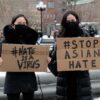Introduction
Welcome to The Moment, a newsletter of conversations and context from people you need to hear. I am Susan Smith Richardson, CEO of the Center for Public Integrity.
When I started in journalism more than 30 years ago, we typically reported about race in terms of Black and white. That racial binary wasn’t accurate then, and it certainly doesn’t hold up today in a multiracial America. As we become a minority-white country, journalists must be willing to cover the complicated narrative around race.
The coronavirus pandemic is complicating the Black-white narrative. As Asian Americans and African Americans experience more racial harassment, including an increase in hate crimes against Asians, the door is opening for a new conversation between two groups that have historically been pitted against each other and reporting about race that focuses on conversations within communities of color. The Center for Public Integrity and news site NextShark recently convened a panel discussion to explore the myth of Asians as the model minority and how the concept affects anti-Black racism. Scot Nakagawa, senior partner of ChangeLab, a racial justice think tank with a focus on Asian Americans, was part of the panel.
And now a moment with Scot Nakagawa…
How does the myth of Asians as the model minority feed into anti-Black racism?
Scot: In terms of the model minority myth, this is something that people in the Asian community have been struggling with for a very long time. I am originally from Hawaii. Hawaii became part of the union much against the will of a majority of the native Hawaiian people largely as the result of a model minority campaign that was waged in Congress to get people to accept what was called an Asiatic majority into the United States.
The myth really originates in the Japanese-American community primarily and immediately in response to Japanese American internment in World War II. Research was done in order to try to make the case that Japanese Americans should be integrated into the white middle class after internment and in order to defend Japanese people against the kinds of attacks they were experiencing in that context. Shortly afterward, those research findings, which were largely manipulated to paint the best picture of Japanese Americans possible, were exploited by conservative politicians to make a case against the Civil Rights Movement.
Floodgates of Immigration
Scot: When we think about that period, the 60s, it’s really important to keep in mind that we had the 1964 Civil Rights Act, the 1965 Voting Rights Act. People often forget that we had the 1965 Immigration and Nationality Act in the context of that civil rights struggle and in the post-World War II period, a war that we fought ostensibly against fascism. Racial bans in immigration were removed. There used to be quotas that favored Europeans. They were removed and opened the floodgates of immigration, particularly from Asia. In part, this was in response to labor shortages that were created by the Vietnam War. So, particularly medical professionals and engineers and what not [came to this country]. People were recruited from Asia who could fill those kinds of jobs in the United States at the time. One of the pillars of the model minority myth was bringing in people from countries that were economically diverse and bringing relatively privileged workers into the United States. There’s a stereotype of South Asians as being doctors, X-Ray technicians and what not. The reason for it is because they were particularly recruited to the United States to fill those shortages.
Immigrant Labor Replacing African American Labor
Scot: That then also happened in concert with the 1964 Civil Rights law, which ultimately caused African Americans in the United States to be protected under the Fair Labor Standards Act, and that made African Americans less exploitable as workers. So immigrant labor started to replace African American labor, especially in farm work and domestic work. African Americans who participated in the workforce at a higher rate than white people going into the civil rights years, shortly after had an unemployment rate twice that of whites.
These dynamics all play in this because in this situation we were pitted against one another, and the model minority myth was one of the ways we were pitted against African Americans and in which white conservatives made the argument for basically blocking civil rights reforms. They were saying ‘If Asian Americans can make it after all they’ve been through then what’s wrong with Black people?’ That’s the long and short of it.
The stereotype of Asian Americans as especially hard working, stoic, uncomplaining, bowing to authority, family oriented, all those kinds of things that make up that myth became a very popular thing in the American media. And they quickly came to envelop the community and cause a huge rift to start to develop between Asian communities and Black communities in the United States.
The Perfectly Exploitable Worker
Scot: Basically, we were described as the perfectly exploitable worker. … It’s certainly something that is repellent to Asian Americans who understand one thing about this myth: Whether or not you are presented to people as superhuman, you are still not being presented as human. We’d like to be understood as human and not as perpetual foreigners or as people who are somehow exceptional. Because if you can be singled out in that way, you can be easily excluded. And we see that happening in the COVID context right now.
For more from Scot and to hear from other panelists, watch Building Black and Asian Allyship in the Age of COVID-19.
We can’t do this work without your support.
Scot’s must reads:
“The Color of Success: Asian Americans and the Origins of the Model Minority,” Ellen Wu — A definitive read about how a confluence of events in the last century created the image of Asians in the United States as model minorities.
“Minor Feelings: An Asian American Reckoning,” Cathy Hong Park — Steeped in personal experience, this series of essays shatters stereotypes about Asian Americans and gives voice to the most economically divided group in the country.
And Scot’s essay, Blackness is the Fulcrum, argues that anti-Black racism enables white supremacy. There may not be a bottom in America’s ever-changing racial hierarchy, he writes, but “the structure of the economy is rooted in slavery.”
Thanks for reading The Moment. What questions do you want to explore? Send them to me at ssmithrichardson@publicintegrity.org. Until next time.
You’re receiving this email because you subscribed to The Center for Public Integrity’s Watchdog Newsletter. If you want to opt out of receiving The Moment, unsubscribe here.





Join the conversation
Show Comments